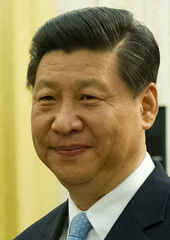Is China Playing With American Fire?
Could such sensitive issues as Muslim relations, maritime activities and international investments tip the United States and China into greater enmity?
February 8, 2013

If you look closely, most reactions to the western Pacific’s recent uptick in tension miss a vital ground truth: The Chinese don’t know with what, or with whom, they are playing.
Fired by superheated growth, dizzy from an elixir of new weapons systems and now deeply indulged by the Xi Jinping leadership, the Chinese security establishment lacks an institutional memory (and a formalized decision-making process) to remind themselves how durable, ruthless and tough Americans can be once they see someone coming hard at them.
This is not good: our Chinese friends need to remember who we are, and remember America’s skills at creating very big mischief at short notice. I think the reason for this memory loss is that they’ve not taken us on for nearly 65 years. And after Nixon’s visit and our strategic cold war policy shift, they got a much freer pass, one they used when fighting their last war, against Vietnam, in 1979.
That’s a long time ago. Today they see us, correctly, playing a lot of poor cards — especially since 2001, if not even earlier. Worse, they don’t know when we can bend, and when we can’t.
But I’m getting ahead of myself: what are the ground truths by which we should assess China in Asia?
Ground Truth One
The US national security establishment consensus has solidified around the sense that America and China have entered what we might call “fated contestation” ever since 1996, when the Chinese test fired missiles near Kaoshiung in Taiwan.
Deeply rooted forces within both countries’ security establishments now drive Sino-American discord. (By “security establishments,” I mean in particular their respective defense industrial/intelligence wings.)
The trend can be abated, but not reversed. The gathering enmity chugs along, impervious to ups and downs in the bilateral trading account or to smiley face diplomacy.
Each security establishment sees the other’s intentions identified along a spectrum ranging from low-grade mischief making to patterned, deliberate and unequivocally hostile moves.
In this dynamic, Western opinion-makers focus on risks of miscalculation. See, for example, Gideon Rachman’s recent column in the Financial Times, in which he sees a possibility that China and Japan could blunder into hostilities like the combatants of World War I.
Yet, comparing current tension to 1914 seems inaccurate, primarily because the current wave of lower level assertiveness by the People’s Liberation Army and the various maritime agencies doesn’t mirror pre-Great War circumstances at all.
In Europe at the time, the miscalculations hinged on each national leadership getting a jump on mobilization, a timeline largely dictated by the specter of a two-front war.
There are other reasons why 1914 doesn’t apply — China has no allies of any consequence, for example. Yet, in other ways, uncomfortable parallels do exist. Just consider the high degree of economic interpenetration between the two principal contestants.
Ground Truth Two
The highest risk lies in miscalculation. When I was serving in the Pentagon during the late 2000s, our interlocutors in countries bordering China found themselves already baffled by China’s moves.
These moves included China’s anti-satellite (ASAT) test in early 2007, which left a great swathe of dangerous rubbish zooming around in orbit, part of Beijing’s developing “A2AD capability” (the latter is Pentagonese for “anti-access and area denial”).
Our Asian friends also wondered aloud why China would act in a way so contrary to its interests. And they added to this another question: Who in China, exactly, fits inside the country’s national security decision-making diagram, and under what circumstances? We had no answer.
Even this wouldn’t be as worrying as it was (and is) to them — were it not for two other problems:
![]() First, there is a deepening hypersensitivity about borders in general and a sense that a “rightfully ours” patch of Chinese influence extends along an ill defined length of the western Pacific.
First, there is a deepening hypersensitivity about borders in general and a sense that a “rightfully ours” patch of Chinese influence extends along an ill defined length of the western Pacific.
![]() Second, the “two hundred years of humiliation” mantra drilled deeply into the Chinese military’s mindset. (Lest we forget, the overtly anti-Japanese “Patriotic Education Campaign” has been underway for 20 years.) Redress of this humiliation, and protection against its recurrence, now amounts to a major source of regime legitimacy in the eyes of the Chinese leadership.
Second, the “two hundred years of humiliation” mantra drilled deeply into the Chinese military’s mindset. (Lest we forget, the overtly anti-Japanese “Patriotic Education Campaign” has been underway for 20 years.) Redress of this humiliation, and protection against its recurrence, now amounts to a major source of regime legitimacy in the eyes of the Chinese leadership.
None of this can be changed. Frankly, it cannot even be reined in very much: The Chinese Communist Party’s senior leadership even seems beholden at present to the Army’s assertive view about how to manage China’s periphery.
Ground Truth Three
Forget the assumed centrality of the Middle East for U.S. policymakers. Ignore the grounding of past U.S. alliances in Europe. Nothing arguably in the still-young American Republic’s history goes back farther than the declared intent, evident in demarches of the 1790s, to reject what we would today call our “strategic denial” by any power from what we used to call the “Far East.”
This means the United States almost automatically opposes the rise of any hegemonic power in the western Pacific.
That’s why A2AD collides so squarely with bedrock American interest. The U.S. resentment of these moves goes back to clipper ships, Commodore Perry’s black ships, the Open Door policy in 1900, the Second World War, and so on without any break in the Cold War and then the post-Cold War.
The United States is, as then Defense Secretary Robert Gates said in Singapore back in 2008, a “resident power” in Asia. This statement is both strictly correct given the geography of the western Aleutians and Guam, and strategically correct from the vantage point of U.S. history, trade and wars.
When I became deputy assistant secretary of defense for Asia after 2007, Chinese assertiveness had already defined what I would do.
In effect, it wrote my job description. Chinese policy and behavior, then and since, has achieved exactly what China ostensibly fears — increasingly explicit moves by India, the heavyweight ASEAN states, Australia and Japan to counter-balance China. All this simply reaffirms the long-settled certitude that America belongs in the western Pacific.
The nice word to use in this situation, and the accurate word, is “balance.” Other Pacific countries like Canada can and do play a modest role in this largely maritime game. The United States is lucky that a lot of moves happen at sea, where a lot can happen far from prying eyes, even in this micro-media infested era.
That’s a good thing. What’s not good in this equation is that the field of play has widened, admitting nationalist cuckoos from various countries that are now lifting the stakes.
It’s not a cliché to say that “face” has now become ever more central to a happy outcome — and “happy” means a return to the old, look-the-other-way status quo. If we don’t get back there soon, the risks of a humiliating climb-down rise ever higher for China, Japan and even for India and the lesser Asian leaderships.
Vietnam knows it is next if Beijing stares down the Japanese. Getting back to the status quo ante means everyone must stand down. And soon.
Ground Truth Four
As an academic, consultant and senior official, I participated in various exercises “gaming out” this evolving Sino-American contention. I didn’t much like where some of these games went, but I’m mainly afraid that the Chinese simply have no idea about how badly and assuredly the United States could mess with them.
The United States is still in “hedging” mode, and I hope this remains in place. After all, the many descriptions of mutual economic interest have a painfully self-evident nature to them. Both countries also have, or should have, a common global agenda in many areas.
The mutuality is accurate. But that’s not the point.
If we Americans tip as a country into clear enmity with China (remember: this sense of enmity has advanced considerably within the national security establishment), then I’m hard pressed to see how some of the following counter-moves won’t end up in debates about how, in our relatively weaker situation, we can play a better hand against a clear “enemy.”
Here are three potential choke points:
1. Muslims in Xinjiang and other peripheral visions
Until the late 1980s, China routinely figured as a target for Muslim advocacy groups, whether Salafi-funded or those more generally concerned from a non-Jihadi viewpoint about the welfare of the “Umma,” i.e., the “community of believers.”
China’s behavior and record in what ethnic nationalists (primarily but not exclusively the Uyghurs) call “East Turkestan” have opened it for criticism since 1949. As the United States drifts away from automatic Jihadi criticism, China will slip back into more prominent pariah status among Muslims.
To some extent, this is inevitable, but turning up the heat remains an option. Consider: Even something as “innocuous” as the opening of a “Uyghur Cultural Center” in Washington would worry the hell out of Beijing.
How about blending it into a “Center for the Study of the Chinese Periphery,” fastidious about “balance” but bundling Tibet with other ethnic issues in Yunnan, Xinjiang and Inner Mongolia?
It would all be purely “academic” of course, with full freedom of discussion and mainstream speakers from China most welcome to participate. I am not advocating this, but it will almost certainly loom as an option if the United States feels the need to play a wider tougher game in the face of unrelenting “assertiveness.”
2. Maritime mischief will backfire
Consider how many lesser contradictions dwell within China’s assertive approach which seems, as noted, to have a self-marginalizing effect. One of these almost jumps out at anyone minimally acquainted with China’s maritime dependency.
Whether for outward trade in finished manufactures, or for imported energy and commodities, China utterly needs a quiet maritime neighborhood.
At least one would think so. I know some engineers disproportionately represented in China’s Party organs that also manage state-owned companies. “Think how piracy at the Horn of Africa kicked up shipping insurance rates,” one said recently.
“If some of the stuff going on was better known, Lloyds [of London] would make a killing,” he added.
Much as they might wish for it, the Chinese authorities don’t control maritime insurance premiums. Any navy — ours, theirs, Australia’s, Japan’s — tends to equate maritime vulnerability with “interdiction.”
But many, many measures well short of that can be used, quickly raising shipping costs for China (and everyone else, of course).
3. Investor panic
Something abrupt like this would, in rapid order, lead to other negative consequences. In Japan, a patient populace earns negative interest from post office savings banks. Don’t imagine that Chinese investors would have the same fond sentiments for home bias if push came to shove.
“Domestic” investors in China include overseas Chinese from Southeast Asia, Taiwan and further afield. If they sense major trouble, from maritime disputes or a slew of other destabilizing moves, I would be surprised if any patriotic impulse got in the way of a decision to join in capital flight.
Some friends in the information technology world are puzzled by continuing Chinese-sponsored intrusion into hitherto cyber-secured areas. “Just imagine,” one said, “if we were to start some reciprocal mischief in Asian banks or even inside the informal payments system!”
None of this is fated to pass — unlike the fated contestation that Chinese behavior since 2004 (and a reciprocal ‘dynamic’ between both security establishments) has now seemingly put in play.
Putting aside breathless journalism, rather little equivalence exists between the capabilities of non-Chinese navies in the western Pacific and the PLA-Navy.
I still believe we are still well short of hair-trigger moves, but I can’t forget the plaintive look in the eyes of our Asian friends back in the 2000s. Their first question — “Why are the Chinese acting against their best interests?” — quickly led to a second: “Who’s in charge there anyway?”
Six years later, we’re not much closer to the answers the United States and Asia need. In some ways, we are even further behind.
Takeaways
The risks of a humiliating climb-down rise ever higher for China, Japan and even for in India.
Getting back to the status quo ante means everyone must stand down. And soon.
The Chinese simply have no idea about how badly and assuredly the United States could mess with them
As the United States drifts away from Afghanistan, China will slip back into more prominent pariah status among Muslims.
Whether for outward trade or for imported energy and commodities, China utterly needs a quiet maritime neighborhood.

